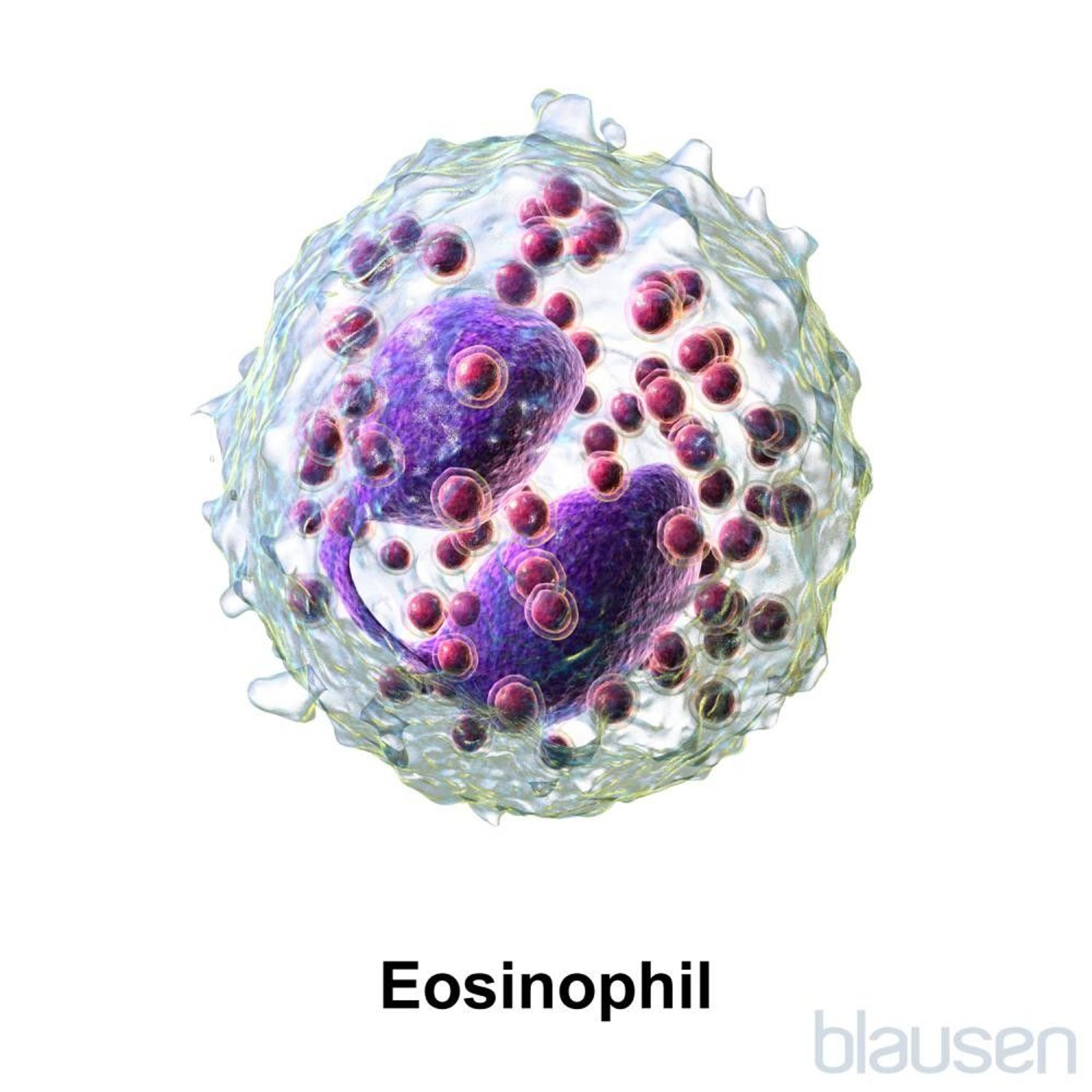Topic Resources
Eosinophils are a type of white blood cell that play an important role in the body's response to allergic reactions, asthma, and infection with parasites. These cells have a role in the protective immunity against certain parasites but also contribute to the inflammation that occurs in allergic disorders.
Sometimes, eosinophils cause inflammation in certain organs that results in symptoms.
Eosinophils usually account for less than 7% of the circulating white blood cells (100 to 500 eosinophils per microliter of blood [0.1 to 0.5 × 109 per liter]).
Low number of eosinophils
A low number of eosinophils in the blood (eosinopenia) can occur with Cushing syndrome, bloodstream infections (sepsis), and treatment with corticosteroids. However, a low number of eosinophils does not usually cause problems because other parts of the immune system compensate adequately.
A low number of eosinophils is usually detected by chance when a complete blood count is done for other reasons.
Treatment of the cause restores the normal number of eosinophils.
High number of eosinophils
The most common causes of a high number of eosinophils (called eosinophilia or hypereosinophilia) are
Allergic disorders
Infections by parasites
Certain cancers
Allergic disorders, including medication sensitivities, asthma (including eosinophilic asthma), allergic rhinitis, and atopic dermatitis, often increase the number of eosinophils. Many parasites, particularly ones that invade tissue, cause eosinophilia. Cancers that cause eosinophilia include Hodgkin lymphoma, leukemia, and certain myeloproliferative neoplasms.
If the number of eosinophils is only slightly elevated, people usually do not have symptoms, and the high number of eosinophils in the blood is only discovered when a complete blood count is done for other reasons. However, sometimes, particularly when the number of eosinophils is very high, the increased number of eosinophils inflames tissues and causes organ damage. The heart, lungs, skin, esophagus, and nervous system are most often affected, but any organ can be damaged.
Symptoms are related to the organ affected. For example, people may have a rash when the skin is affected, wheezing and shortness of breath when the lungs are affected, shortness of breath and fatigue (symptoms of heart failure) when the heart is affected, or throat and stomach pain when the esophagus or stomach is affected. Accordingly, eosinophilic disorders are diagnosed according to the location where the levels of eosinophils are elevated:
Eosinophilic cardiomyopathy (heart)
Eosinophilic colitis (large intestine)
Eosinophilic enteritis (small intestine)
Eosinophilic esophagitis (esophagus)
Eosinophilic gastritis (stomach)
Eosinophilic pneumonia (lungs)
Often, people are first tested and treated for more common causes of their symptoms. For example, they might undergo testing for infection and even receive antibiotics even though no infection is found. When people still have symptoms after treatment, doctors often take a sample of tissue for examination (biopsy), which will show eosinophils within the organ that is affected.
Treatment of these conditions frequently includes oral corticosteroids.
Hypereosinophilic syndrome
Hypereosinophilic syndrome is an uncommon disorder in which the number of eosinophils increases to more than 1,500 cells per microliter of blood (more than 1.5 × 109 per liter) for more than 6 months without an obvious cause. Some people have a rare chromosome disorder.
People of any age can develop hypereosinophilic syndrome, but it is more common in men older than 50. The increased number of eosinophils can damage the heart, lungs, liver, skin, and nervous system. For example, the heart can become inflamed in a condition called Löffler endocarditis, leading to formation of blood clots, heart failure, heart attacks, or malfunctioning heart valves.
Symptoms may include weight loss, fevers, night sweats, fatigue, cough, chest pain, swelling, stomachache, rash, pain, weakness, confusion, and coma. Additional symptoms of this syndrome depend on which organs are damaged.
The syndrome is suspected when repeated blood tests reveal that the number of eosinophils is persistently increased in people who have these symptoms. The diagnosis is confirmed when doctors determine that the eosinophilia is not caused by a parasitic infection, an allergic reaction, or another diagnosable disorder and when biopsies show eosinophils within organs.
Without treatment, generally more than 80% of the people who have this syndrome die within 2 years, but with treatment, more than 80% survive. Heart damage is the principal cause of death. Some people need no treatment other than close observation for 3 to 6 months, but most need treatment with prednisone, hydroxyurea, or chemotherapy agents. Without treatment, generally more than 80% of the people who have this syndrome die within 2 years, but with treatment, more than 80% survive. Heart damage is the principal cause of death. Some people need no treatment other than close observation for 3 to 6 months, but most need treatment with prednisone, hydroxyurea, or chemotherapy agents.
Some people with hypereosinophilic syndrome have an acquired abnormality of a gene that regulates cell growth. This type of hypereosinophilia can respond to treatment with imatinib, a medication used to treat cancer. Some people with hypereosinophilic syndrome have an acquired abnormality of a gene that regulates cell growth. This type of hypereosinophilia can respond to treatment with imatinib, a medication used to treat cancer.
If treatment with these medications is not successful, various other medications may be used, and they can be combined with a procedure to remove eosinophils from the blood (leukapheresis).


